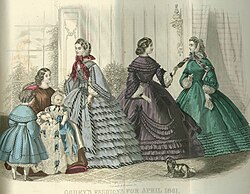

Engageantes are false sleeves worn with women's clothing. They were worn during the 18th and 19th centuries, with a brief revival in the 20th century. In the 18th century, engageantes took the form of ruffles or flounces of linen, cotton, or lace, tacked to the elbow-length sleeves then fashionable. [1]
In the mid-19th century, the term engageante was used for separate false sleeves, usually with fullness gathered tight at the wrist, worn under the open bell-shaped "pagoda" sleeves of day dresses. The fashion reappeared briefly just after the turn of the 20th century.[ citation needed ]